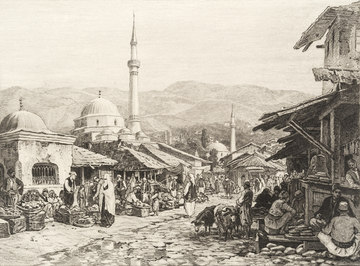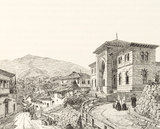Sharia under the Double Eagle: Austria-Hungary and the Bosnian Muslims
Attempts to model the administration, school system and judiciary on the structures in other parts of the empire offer interesting examples of the integrative potential of the Habsburg Monarchy.
As in other lands in the empire, the administrative structure was restricted not just to state authorities but also to the organization of religious communities. The Catholic parish and bishopric network was reorganized and an archbishopric created in Sarajevo for the Catholics there. The situation was somewhat more complicated for the orthodox Christian population. So as not to increase the pressure by the Bosnian Serbs for unification with the Serbian motherland, an independent orthodox church structure was created in Bosnia by agreement with the orthodox Patriarch in Constantinople, which remained as a separate institution from the Serbian structure.
The Austrian authorities were confronted by a completely new situation with the Bosnian Muslims. There was no hierarchically organized clergy in the western sense. The authorities were local muftis appointed by the Sultan to adjudicate and organize religious life. This mixture of spiritual and temporal power without clear structures was inacceptable to the Austro-Hungarian authorities. An attempt was therefore made to create a Muslim community structure in the form of a ‘national church’ for the Bosnian Muslims under Austrian supervision. The underlying idea was to neutralize the authority of the Sultan, who had hitherto been the traditional head of the local Muslims in both political and religious matters. The Austro-Hungarian authorities prevented the Sultan from exerting an influence on the appointment of the local clergy. In 1881 it was decided that in future the local elites rather than the Sultan should appoint their mufti.
In 1882 the mufti of Sarajevo, Hilmi Hadžiomerović, was made mufti of the whole of Bosnia and was given control of the sharia court. On the initiative of the Austro-Hungarian authorities, this court was to be presided over by a four-man council – like an episcopal synod. Hadžiomerović even travelled in 1882 to Vienna to thank the Emperor for his appointment. The audience with a Muslim dignitary was the first of its kind in the Vienna court.
In 1909 the Muslim communities were granted autonomy in their financial administration and organization of educational establishments and religious institutions. The structure of the Islamic communities was based on the Christian bishoprics and parishes.
As for legal jurisdiction, allowance was made for the specific situation. As citizens of the Habsburg Monarchy, Bosnian Muslims were subject to Austro-Hungarian civil law, but questions of family and inheritance law were left to the sharia. The Muslim legal scholars were not only appointed and paid by the Austro-Hungarian administration but also constrained to cooperate with the civil jurisdiction, also in terms of court procedure. To provide training in both legal traditions, a state Islamic school of law was established in Sarajevo in 1887. The prestigious historicist building in the neo-Moorish style is today the seat of the Faculty of Islamic Law of the University of Sarajevo.
Translation: Nick Somers
Buchmann, Bertrand Michael: Österreich und das Osmanische Reich. Eine bilaterale Geschichte, Wien 1999
Džaja, Srećko: Bosnien-Herzegowina in der österreichisch-ungarischen Epoche (1878–1918) (Südosteuropäische Arbeiten 93), München 1994
Hösch, Edgar: Geschichte der Balkanländer. Von der Frühzeit bis zur Gegenwart, München 1999
Rumpler, Helmut: Eine Chance für Mitteleuropa. Bürgerliche Emanzipation und Staatsverfall in der Habsburgermonarchie [Österreichische Geschichte 1804–1914, hrsg. von Herwig Wolfram], Wien 2005
-
Chapters
- The Croats in the Habsburg Monarchy
- ‘Loyal rebels: the role of the Croats in the 1848 revolution
- The question of autonomy: the Croats caught between Vienna and Budapest
- The Serbs in the Habsburg Monarchy
- ‘Serbs all and everywhere’: the Serb national programme
- The Bosnians in the Habsburg Monarchy
- Sharia under the Double Eagle: Austria-Hungary and the Bosnian Muslims
- From Illyrism to Yugoslavism: competing concepts for a southern Slav nation
- Friend or foe? The positions of the southern Slavs in the First World War





